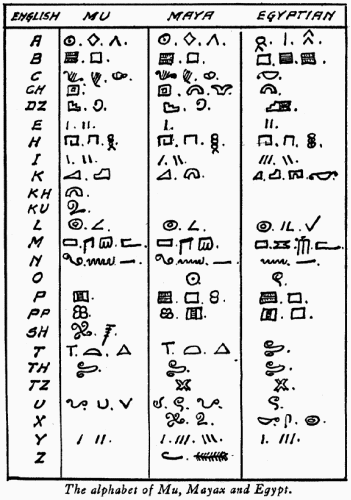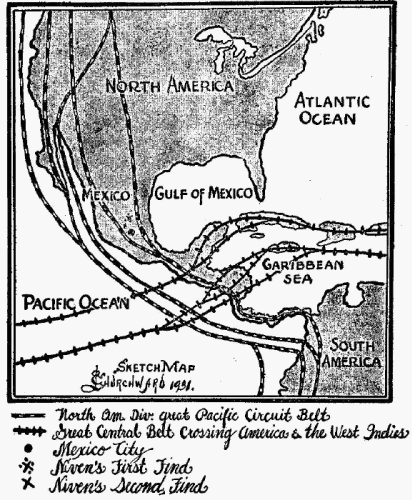|
CHAPTER III
We assume, basing our assumption on modern history, that Mu expanded while her civilization was in its early stages. We, therefore, picture to ourselves an ancient craft leaving the shores of Mu, the Motherland, manned by a crew of stalwart, young adventurers with milk-white skins, blue eyes and light, flaxen hair. When their craft was fairly launched upon the Eastern Sea, they pointed its prow towards the rising sun.
A hundred thousand years or
more, after man first appeared on Mu, found him so increased in
numbers that the area of available land of the Motherland became
insufficient to sustain the ever growing population. So these young
men had started out to find other lands, if they existed anywhere on
this globe.1
At the end of a moon's journey,3 as the rays of the morning sun were lighting up the horizon ahead, the crew saw ahead of their craft a long line of surf breaking on a low, sandy shore, with a low, rolling country beyond.
2. I have found in ancient records that in various parts of the Motherland, the tribes or people were called after the name of their symbol for the Creator and creation. The Nagas are another noted example. 3. In so far as I have been able to find out, the ancients kept track of time by the itars. Dates in this book, whenever given, are based upon astronomical charts found engraved in ancient writings.
On nearing the surf, they turned the prow of their craft and skirted the shore line until they came to a stretch of less turbulent Water.
This they crossed and found
themselves at the mouth of a river. They proceeded inland until they
came to a suitable landing place where they drew their boat up on
the bank and made camp. From the camp they explored the surrounding
country, finding it unoccupied by man and eminently adapted for a
settlement. They then returned to the Motherland with the good news.
What is now Guatemala is where they
built their capital city and elected a king.
There is no spot on earth that has a greater attraction and fascination for the lovers of the ancient than the Valley of Mexico.
A series of tragedies has followed man in this valley, starting from the very beginning of his appearance in America. Take the first settlers. After many years of successful development, extension and expansion, and after building great cities and imposing temples, a huge cataclysmic wave from the ocean rolled in over the land, leveling the cities and temples and blotting out all human life.
When the waters finally subsided they
left behind a stratum of boulders, gravel and sand which blanketed
the whole country, burying the remains of the cities and temples.
The remains of this, their first great city, lie 29 miles north of
Mexico City. 4
4 See The Lost Continent of Mu, page 206.
The waters from the ocean rolled in and filled up the abyss caused by the land sinking. This submerged the Valley of Mexico.
The submersion was accompanied by terrific volcanic workings. Earthquakes followed one another in quick succession. The land opened and volcanoes burst forth, vomiting fire, smoke and rivers of lava, which spread out over the country, carrying death and destruction in their wake.
Some of these ancient craters with their lava flows still
remain. A noted one is called Xitli: its lava flow extends about 25
miles and ends on the very edge of Mexico City. The flow is about 25
feet thick, showing the enormous ejection.
The legend runs as follows:
This is a typical Aztec production but lacks the usual amount of
Aztec frills, ribbons and inventions. It comes out of two separate
and distinct legends - one the submergence of the Valley of Mexico,
the other the destruction and submergence of Mu, the Motherland.
This certainly was "a new era in the history of the
world."
As these ranges were being lifted
they carried the valley between them up several thousand feet. If at
the time these mountains were being raised Mexico was inhabited, it
is safe to say that nearly all of the people perished, as was the
case in all other areas where mountains were raised.
This tepetate rock is found not only
in the valley itself but high up on the mountainsides which surround
it. Egyptian records say that this rock was laid down about 16,000
years ago. How long afterwards it emerged again is not known but
from the character of the rock, if we may judge from that, it could
not have been very long under water, comparatively speaking.
The Mexican Mountains being of recent origin, and being
continuations of our own western ranges, proves that all of the
mountain ranges in western North America are of recent origin.
I now come to Niven's second great discovery in Mexico. In little hamlets and villages 4 to 6 miles northwest of Mexico City at a depth of from 17 to 18 feet below the surface, Niven discovered still another Mexican prehistoric civilization.
Among the many treasures which he found were 2600
stone tablets. He has gone to the extreme trouble and monumental
labor of making tracings of every one and sending them to me. When
sending some of the first tracings he wrote: "I have been informed
by professors (mentioning the names of many) and dozens of others,
both American and foreign, that they were symbols unlike anything
they had ever seen."
Mu, the Motherland, is the key to all ancient writings.
The most ancient writings that I have ever seen are of either a religious or a scientific character. Some are about Mu and nothing else. The alphabet of the Motherland consisted of 16 letters and many diphthongs. Each letter had three different glyphs expressing it. The first is the hieratic letter which also carries a hidden meaning.
The second is used in the body of words generally,
and the third is used as an adjective or to emphasize. The esoteric
or hidden meaning of the hieratic letters was known only to the
priesthood and not even to all of them. In most cases the hidden
meaning symbolized something - M was the alphabetical symbol for Mu, H
the alphabetical symbol for the Sacred Four, and A for the Creator,
the Deity.
Strange as it may appear, the writings on
some of the tablets are identical in their religious conceptions
with what has recently been found in Babylonia.
At this I find myself confronted with a peculiar condition hard to explain satisfactorily to myself.
This civilization was in no way primitive. On the contrary, in science they were far ahead of us today.
Their knowledge of the Cosmic Forces, which our scientists
today call "energy" for want of the knowledge of their origin, was
evidently perfect. A primitive civilization could not have written
these tablets. They are the exposition of the knowledge of a
profound science which has only just dawned on the scientific world
of today and which has not as yet been learned and mastered by
modern man.
The writings are queer; yet queer as they are, they are the first words spoken for us to understand from those, who lived in America over 12,000 years ago. On these tablets is told the form of government among these people.
From the decipherings which will follow, all who read must feel
convinced that their religious conceptions and cosmogony were of a
very high order. What is more, they thoroughly understood what they
were writing about.
They state that:
Their principal symbol was the Sun as the monotheistic or collective symbol of the Creator.
Their religion was monotheistic. They acknowledged only One Supreme
which they worshiped through a collective symbol, the Sun. The
Supreme, the Creator was given many attributes each of which was
symbolized. Great stress apparently was laid on the fact that these
attributes were only powers of the One Supreme.
In all very ancient writings one comes across the word god.
It reads the god this, the god that. Generally
we find a name given to the god such as the Chaldean "the god
Belmarduk," the Egyptian "the god Thoth," etc. The ancients did not
refer to the Creator: to them He was the Supreme. Their meaning was
a Cosmic Force originating with the Creator.
As it was the combined action, or the joining together or coming in contact with each other, it was popularly symbolized as a marriage of the gods - marriage of the two forces. It was probably expressed as a marriage to enable the ancient layman better to understand the phenomenon. Thus we find he was taught that the god A married the goddess B and they produced C.
In the Sacred Writings we find the same phenomenon expressed in temple language, Commands in Creation.
6 May be read as arrow, spear and javelin.
The foregoing is the form of temple writing and not the form of
teaching the layman. The Priesthood in turn, to make it more
understandable to the layman, symbolized the forces as gods - the
first four gods were the Four Great Primary Forces.
So the soul of man possessing Cosmic Forces was appropriately added to the list of gods. Still later on we find the word god added to the names of the Creator. The earliest of these applications which I can find is in the Bible where the Deity is called God and Lord God.
Since then it has become His most popular
name. From about 2500 years ago we drop down to present times.
Our scientific men, being unable to comprehend the difference between the ancient past god and our present God, have assumed that to the ancients all their gods were Deities and thus they conceived of and worshiped many Gods.
Thus science has formed such a scramble that it
has clogged and badly stuck the layman's attitude on this subject,
but this is nothing new in man's history.
Before closing this chapter it does not seem amiss to explain why the Valley of Mexico was so often overrun with cataclysmic waves from the oceans.
I have made a sketch which seems to me to be sufficient to show what is required. The volcanic conditions in and around Mexico and the West Indies
The broken lines running from a northerly direction to a southerly direction are parallels or divisions of the Great Pacific Circuit Gas Belt, 7 the largest within the crust of the earth. On the west of Mexico underneath the ocean three parallels or divisions of this gas belt are shown.
Another two divisions of the same belt are shown coming down underneath the land.
7. See The Lost Continent of Mu, page 252.
Running from east to west
are shown the two divisions of the Great Central Gas Belt which runs
completely around the earth. This belt has a vast number of
parallels, splits, loops, etc., commencing out in the Pacific Ocean,
doubling up through Yucatan and Central America and tapering down
again after leaving the Continent.
The divisions of these belts which lay underneath the land
were the responsible agents for the raising of the mountains. Return to Messages From Andean and American Civilizations
|

